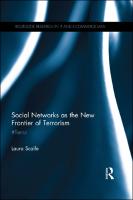Social Networks as the New Frontier of Terrorism
#Terror
| dc.contributor.author | Scaife, Laura | |
| dc.date.accessioned | 2022-02-10T12:47:59Z | |
| dc.date.available | 2022-02-10T12:47:59Z | |
| dc.date.issued | 2017 | |
| dc.identifier | ONIX_20220210_9781317361855_14 | |
| dc.identifier.uri | https://library.oapen.org/handle/20.500.12657/52759 | |
| dc.description.abstract | Terrorism. Why does this word grab our attention so? Propaganda machines have adopted modern technology as a means to always have their content available. Regardless of the hour or time zone, information is being shared by somebody, somewhere. Social media is a game changer influencing the way in which terror groups are changing their tactics and also how their acts of terror are perceived by the members of the public they intend to influence. This book explores how social media adoption by terrorists interacts with privacy law, freedom of expression, data protection and surveillance legislation through an exploration of the fascinating primary resources themselves, covering everything from the Snowden Leaks, the rise of ISIS to Charlie Hebdo. The book also covers lesser worn paths such as the travel guide that proudly boasts that you can get Bounty and Twix bars mid-conflict, and the best local hair salons for jihadi brides. These vignettes, amongst the many others explored in this volume bring to life the legal, policy and ethical debates considered in this volume, representing an important part in the development of understanding terrorist narratives on social media, by framing the legislative debate. This book represents an invaluable guide for lawyers, government bodies, the defence services, academics, students and businesses. | |
| dc.language | English | |
| dc.relation.ispartofseries | Routledge Research in Information Technology and E-Commerce Law | |
| dc.subject.classification | thema EDItEUR::L Law::LN Laws of specific jurisdictions and specific areas of law::LNQ IT and Communications law / Postal laws and regulations | en_US |
| dc.subject.classification | thema EDItEUR::L Law::LN Laws of specific jurisdictions and specific areas of law::LNJ Entertainment and media law | en_US |
| dc.subject.other | Communications Act 2003 | |
| dc.subject.other | Crime and Disorder Act 1998 | |
| dc.subject.other | human rights law | |
| dc.subject.other | ISIS | |
| dc.subject.other | information society service | |
| dc.subject.other | legal and regulatory frameworks | |
| dc.subject.other | Malicious Communications Act 1988 | |
| dc.subject.other | Public Order Act 1986 | |
| dc.subject.other | Regulation of Investigatory Powers Act 2000 | |
| dc.subject.other | Right to Freedom of Expression | |
| dc.subject.other | regulation of online content | |
| dc.subject.other | Serious Crime Act 2007 | |
| dc.subject.other | social media | |
| dc.subject.other | Terrorism Act 2000 | |
| dc.subject.other | terrorism | |
| dc.subject.other | traditional media | |
| dc.subject.other | United Nations Counter-Terrorism Committee | |
| dc.title | Social Networks as the New Frontier of Terrorism | |
| dc.title.alternative | #Terror | |
| dc.type | book | |
| oapen.identifier.doi | 10.4324/9781315668680 | |
| oapen.relation.isPublishedBy | 7b3c7b10-5b1e-40b3-860e-c6dd5197f0bb | |
| oapen.relation.isFundedBy | Knowledge Unlatched | |
| oapen.relation.isbn | 9781317361855 | |
| oapen.relation.isbn | 9780367874995 | |
| oapen.relation.isbn | 9781315668680 | |
| oapen.relation.isbn | 9781138950535 | |
| oapen.collection | Knowledge Unlatched (KU) | |
| oapen.imprint | Routledge | |
| oapen.pages | 216 | |
| oapen.grant.number | 7200 | |
| peerreview.anonymity | Single-anonymised | |
| peerreview.id | bc80075c-96cc-4740-a9f3-a234bc2598f1 | |
| peerreview.open.review | No | |
| peerreview.publish.responsibility | Publisher | |
| peerreview.review.stage | Pre-publication | |
| peerreview.review.type | Proposal | |
| peerreview.reviewer.type | Internal editor | |
| peerreview.reviewer.type | External peer reviewer | |
| peerreview.title | Proposal review | |
| oapen.review.comments | Taylor & Francis open access titles are reviewed as a minimum at proposal stage by at least two external peer reviewers and an internal editor (additional reviews may be sought and additional content reviewed as required). |

